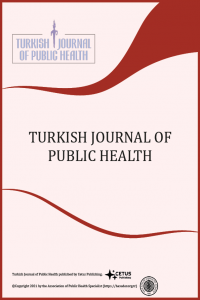Bir prospektif kohort çalışmasının temel verileri: Kapadokya kohort çalışması, Türkiye
Kohort çalışmaları, müdahale çalışması, kronik hastalıklar, risk faktörleri
Baseline data of a prospective cohort study: Cappadocia cohort study, Turkey
Cohort studies, intervention study, chronic diseases, risk factors,
___
- 1. World Health Organization (WHO). Noncommunicable diseases, Available at: http://who.int/mediacentre/factsheets/fs355/en/ Accessed January 24, 2015. 2. GBD 2013 Mortality and Causes of Death Collaborators. Global, regional, and national age-sex specific all-cause and cause-specific mortality for 240 causes of death, 1990-2013: a systematic analysis for the Global Burden of Disease Study 2013. Lancet 2015;385(9963):117-171. 3. Turkish Statistical Institute. Adrese Dayalı Nüfus Kayıt Sistemi Sonuçları, 2014. Available at: http://www.tuik.gov.tr/PreHaberBultenleri.do?id=18616 Accessed February 11, 2015. 4. Sengul S, Erdem Y, Akpolat T, et al. Controlling hypertension in Turkey: not a hopeless dream. Kidney Int Suppl 2013;3(4):326-31. 5. Kilic B, Kalaca S, Unal B, Phillimore P, Zaman S. Health policy analysis for prevention and control of cardiovascular diseases and diabetes mellitus in Turkey. Int J Public Health 2015;60 Suppl 1:47-53. 6. Akgün S, Rao C, Yardim N, et al. Estimating mortality and causes of death in Turkey: methods, results and policy implications. Eur J Public Health 2007;17(6):593-9. 7. Satman I, Omer B, Tutuncu Y, et al. Twelve-year trends in the prevalence and risk factors of diabetes and prediabetes in Turkish adults. Eur J Epidemiol 2013;28(2):169-180. 8. Erdem Y, Arici M, Altun B, et al. The relationship between hypertension and salt intake in Turkish population: SALTURK study. Blood Press 2010;19(5):313-8. 9. The Republic of Turkey Ministry of Health. Global Adult Tobacco Survey Turkey Report. Available at: http://www.who.int/tobacco/surveillance/en_tfi_gats_turkey_2009.pdf?ua=1 Accessed February 11, 2015. 10. Aygul N, Ozdemir K, Abaci A, et al. Comparison of traditional risk factors, angiographic findings, and in-hospital mortality between smoking and nonsmoking Turkish men and women with acute myocardial infarction. Clin Cardiol 2010;33(6):E49-54. 11. Ministry of Health of the Republic of Turkey. Health Transformation Program, Ankara, Turkey, 2003. Available at: http://www.saglik.gov.tr/TR/belge/1-2906/ saglikta-donusum-programi.html Accessed June 22, 2018. 12. Phillimore P, Zaman S, Ahmad B, et al. Health system challenges of cardiovascular disease and diabetes in four Eastern Mediterranean countries. Glob Public Health 2013;8(8):875-89. 13. Fathima FN, Joshi R, Agrawal T, et al. Rationale and design of the Primary pREvention strategies at the community level to Promote Adherence of treatments to pREvent cardiovascular diseases trial number (CTRI/2012/09/002981). Am Heart J 2013;166(1):4-12. 14. Puska P. From Framingham to North Karelia: from descriptive epidemiology to public health action. Prog Cardiovasc Dis 2010;53(1):15-20. 15. Farquhar JW, Fortmann SP, Maccoby N, et al. The Stanford Five-City Project: design and methods. Am J Epidemiol 1985;122(2):323-34. 16. Keys A. Seven Countries: A Multivariate Analysis of Death and Coronary Heart Disease. Cambridge: Harvard University Press, 1980. 17. Weinehall L, Hellsten G, Boman K, Hallmans G. Prevention of cardiovascular disease in Sweden: the Norsjo community intervention programme--motives, methods and intervention components. Scand J Public Health Suppl 2001;56:13-20. 18. Puska P. The North Karelia Project: nearly 20 years of successful prevention of CVD in Finland. Hygie 1992;11(1):33-5. 19. Jeffery RW. Community programs for obesity prevention: the Minnesota Heart Health Program. Obes Res 1995;3 Suppl 2:283-8. 20. Faich GA, Ellis S, Belloni JS, Fishbein HA. The Rhode Island Diabetes Intervention Program. R I Med J 1979;62(6):229-32. 21. Kamath DY, Xavier D, Gupta R, et al. Rationale and design of a randomized controlled trial evaluating community health worker-based interventions for the secondary prevention of acute coronary syndromes in India (SPREAD). Am Heart J 2014;168(5):690-7. 22. Turkish Statistical Institute. Seçilmiş Göstergelerle Nevşehir 2013. Available at: http://www.tuik.gov.tr/ilGostergeleri/iller/NEVSEHIR.pdf Accessed June 21, 2018 23. Centers for Disease Control and Prevention (CDC). State-specific secondhand smoke exposure and current cigarette smoking among adults - United States, 2008. MMWR Morb Mortal Wkly Rep 2009;58(44):1232-5. 24. Grundy SM, Cleeman JI, Daniels SR, et al. Diagnosis and management of the metabolic syndrome: an American Heart Association/National Heart, Lung, and Blood Institute scientific statement: Executive Summary. Crit Pathw Cardiol 2005;4(4):198-203. 25. Johansson G, Westerterp KR. Assessment of the physical activity level with two questions: validation with doubly labeled water. Int J Obes (Lond) 2008;32(6):1031-3. 26. Turkish Statistical Institute (TURKSTAT). Address Based Population Registration System Results, Available at: http://www.turkstat.gov.tr/Kitap.do?metod=KitapDetay&KT_ID=11&KITAP_ID=139 27. Hacettepe University Institute of Population Studies, T.R. Ministry of Development and TÜBİTAK. 2013 Turkey Demographic and Health Survey. Available at: http://www.hips.hacettepe.edu.tr/eng/TDHS_2013_main.report.pdf 28. Ministry of Labour and Social Security. Net minimum wage by years. Available at: https://www.csgb.gov.tr/en/Contents/Istatistikler/AsgariUcret Accessed June 22, 2018 29. World Health Organization (WHO). Noncommunicable Diseases (NCD) Country Profiles. Available at: http://www.who.int/nmh/countries/tur_en.pdf Accessed 2015 30. Altun B, Arici M, Nergizoğlu G, et al. Prevalence, awareness, treatment and control of hypertension in Turkey (the PatenT study) in 2003. J Hypertens 2005;23(10):1817-2
- Başlangıç: 2003
- Yayıncı: Halk Sağlığı Uzmanları Derneği
Bir prospektif kohort çalışmasının temel verileri: Kapadokya kohort çalışması, Türkiye
Serhat UNAL, Sibel ASCİOGLU, Ahmet DEMİRKAZİK, İhsan ERTENLİ, Erdal ESKİOGLU, Kerim GULER, Sedat KİRAZ, Mert OZBAKKALOGLU, Birol OZER, Tufan TUKEK, Mine Durusu TANRİOVER, Eda AKYAR, Pelin CAGATAY, Yunus ERDEM
İnternet bağımlılığı lise öğrencilerinde kötü uyku kalitesini artırıyor
Mısır Sharkia Valiliğinin kırsal kesiminde yaşlılar arasında düşmeler
Amel Elwan MOHAMMED, Eman Elshahat ORABİ, Howida HENNERY
Manisa ilinde kabakulak seroprevalansı ve bazı sosyal belirleyicilerle ilişkisi, 2014
Yasin SAĞLAM, Özgen Alpay ÖZBEK, Duygu İŞLEK, Can Hüseyin HEKİMOĞLU, Nur DEMİRPENÇE, Mestan EMEK, Sema Alp ÇAVUŞ, Gonca ATASOYLU, İbrahim Mehmet Ali ÖKTEM, Belgin ÜNAL
Predatory Dergi Tehlikesi Büyüyor
Bir üniversite çalışanlarının beslenme okuryazarlığı, beslenme davranışları ve ilişkili faktörler
Gülcan DEMİR ÖZDENK, Lütfiye Hilal ÖZCEBE
Penang’da sağlık turizminin halk sağlığı etkileri ve sonuçları
Acil yardım ve afet yönetimi öğrencilerinin sağlıklı yaşam biçimi davranışları
